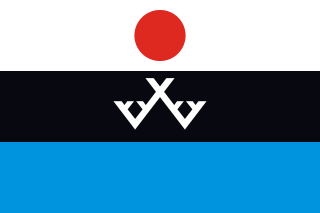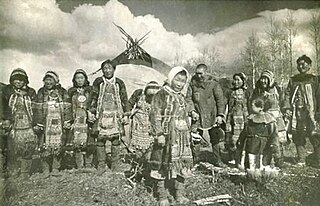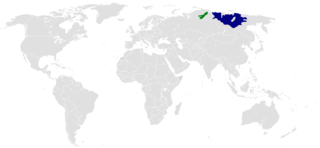
The Evenks are a Tungusic people of North Asia. In Russia, the Evenks are recognised as one of the Indigenous peoples of the Russian North, with a population of 38,396. In China, the Evenki form one of the 56 ethnic groups officially recognised by the People's Republic of China, with a population of 30,875. There are 537 Evenks in Mongolia, called Khamnigan in the Mongolian language.

The Tungusic languages form a language family spoken in Eastern Siberia and Manchuria by Tungusic peoples. Many Tungusic languages are endangered. There are approximately 75,000 native speakers of the dozen living languages of the Tungusic language family. The term "Tungusic" is from an exonym for the Evenk people (Ewenki) used by the Yakuts ("tongus").
The Oroqen people are an ethnic group in northern China. They form one of the 56 ethnic groups officially recognized by the People's Republic of China. The Oroqen people are largely concentrated in the northern Chinese provinces of Heilongjiang and Inner Mongolia, which are home to 45.54% and 41.94% of the 8,259 Oroqen people living in China. The Oroqen Autonomous Banner is also located in Inner Mongolia.

The Nanai people are a Tungusic people of East Asia who have traditionally lived along Heilongjiang (Amur), Songhuajiang (Sunggari) and Wusuli River (Ussuri) on the Middle Amur Basin. The ancestors of the Nanai were the Wild Jurchens of northernmost Manchuria.
Evenki, formerly known as Tungus, is the largest member of the northern group of Tungusic languages, a group which also includes Even, Negidal, and the more closely related Oroqen language. The name is sometimes wrongly given as "Evenks". It is spoken by Evenks or Ewenkī(s) in Russia and China.

Carib or Kari'nja is a Cariban language spoken by the Kalina people (Caribs) of South America. It is spoken by around 7,400 mostly in Brazil, The Guianas, and Venezuela. The language is currently classified as highly endangered.
Chulym, also known as Chulim, Chulym-Turkic, is a critically endangered language of the Chulyms. The names which the people use to refer to themselves are 1. пистиҥ кишилер, pistɪŋ kiʃɪler and 2. ось кишилер, øs kiʃɪler. The native designation for the language are ось тил(и), øs til(ɪ) ~ ø:s til(ɪ), and less frequently тадар тил(и), tadar til(ɪ).

Negidals are an Indigenous ethnic group in the Khabarovsk Krai in Russia, who live along the Amgun River and Amur River.
The Even languageə-VEN, also known as Lamut, Ewen, Eben, Orich, Ilqan, is a Tungusic language spoken by the Evens in Siberia. It is spoken by widely scattered communities of reindeer herders from Kamchatka and the Sea of Okhotsk in the east to the Lena river in the west and from the Arctic coast in the north to the Aldan river in the south. Even is an endangered language with only some 5,700 speakers. These speakers are specifically from the Magadan region, the Chukot region and the Koryak region. The dialects are Arman, Indigirka, Kamchatka, Kolyma-Omolon, Okhotsk, Ola, Tompon, Upper Kolyma, Sakkyryr and Lamunkhin.
Oroqen, also known as Orochon, Oronchon, Olunchun, Elunchun or Ulunchun, is a Northern Tungusic language spoken in the People's Republic of China. Dialects are Gankui and Heilongjiang. Gankui is the standard dialect. It is spoken by the Oroqen people of Inner Mongolia and Heilongjiang in Northeast China.
The Ulch language, or Olcha, is a Tungusic language spoken by the Ulch people in the Russian Far East. The language is moribund, with only 150 speakers.

Tungusic peoples are an ethnolinguistic group formed by the speakers of Tungusic languages. They are native to Siberia, China, and Mongolia.
The Nanai language is spoken by the Nanai people in Siberia, and to a much smaller extent in China's Heilongjiang province, where it is known as Hezhe. The language has about 1,400 speakers out of 17,000 ethnic Nanai, but most are also fluent in Russian or Chinese, and mostly use one of those languages for communication.
Taz is a dialect of Northeastern Mandarin formerly spoken by the Taz people of the Russian Far East. There are a few loanwords from Tungusic languages, but no obvious Tungusic effect on the grammar.

Rutul or Rutulian is a language spoken by the Rutuls, an ethnic group living in Dagestan (Russia) and some parts of Azerbaijan. It is spoken by 30,000 people in Dagestan and 17,000 in Azerbaijan. The word Rutul derives from the name of a Dagestani village where speakers of this language make up the majority.
Hakha Chin, or Laiholh, is a Kuki-Chin language spoken by 446,264 people, mostly in Myanmar. In Mizoram, the language is recognized as Pawi. The total figure includes 2,000 Zokhua and 60,100 Hakha speakers. The speakers are largely concentrated in Chin State in western Myanmar and Mizoram in eastern India, with a small number of speakers in south-eastern Bangladesh.
Uilta is a Tungusic language spoken in the Poronaysky and Nogliksky Administrative Divisions of Sakhalin Oblast, in the Russian Federation, by the Uilta people. The northern Uilta who live along the river of Tym’ and around the village of Val have reindeer herding as one of their traditional occupations. The southern Uilta live along the Poronay near the city of Poronaysk. The two dialects come from the northern and eastern groups, however, they have very few differences.
The Oroch language is a critically endangered language spoken by the Oroch people in Siberia. It is a member of the southern group of the Tungusic languages and is closely related to the Nanai language and Udege language. It is or was spoken in the Khabarovsk Krai. The language is split into three dialects: Tumninsky, Khadinsky, and Hungarisky. At the beginning of the 21st century, a written form of the language was created. The Russian government and the scientific field disagree on whether the language is living or extinct. The Oroch language belongs to the southern subgroup of the Tungus-Manchu languages, which are part of the Altaic family of languages.

Yakutyə-KOOT, also known as Yakutian, Sakha, Saqa or Saxa, is a Turkic language belonging to Siberian Turkic branch and spoken by around 450,000 native speakers, primarily the ethnic Yakuts and one of the official languages of Sakha (Yakutia), a federal republic in the Russian Federation.
Khamnigan is a Mongolic language spoken by the Hamnigan people east of Lake Baikal.








